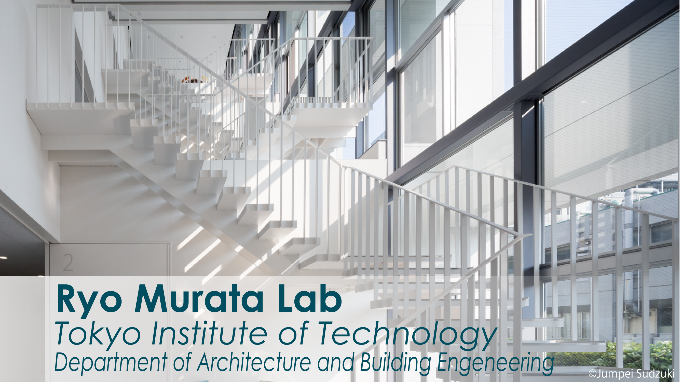|  画像クリックでYouTubeに飛びます。紹介動画をご覧ください。 Click the above image to link the lab introduction video on YouTube. 画像クリックでYouTubeに飛びます。紹介動画をご覧ください。 Click the above image to link the lab introduction video on YouTube.
村田涼研究室では「環境に応答した建築・都市がいかにしてつくられるのか」を主なテーマとし、さまざまな歴史的、地理的な文脈と建築・都市の関係を考察することで、優れた建築環境の実体的な仕組みを明らかにすることを主題とした研究・設計を行っています。
例えば、中庭や窓といった構成要素には、建築と自然を媒介する装置としての面白さがあります。これらは建物の内と外をつなぐインターフェースとして、私たちの生活を取り巻く環境が時代や場所によって変化すると共に、実に多様な実践を派生しています。つまりこのような建築の構成要素の形式は、いわば地域の環境的なポテンシャルを表すバロメーターのように、あるいはその時代の生活や建築技術を映す鏡のように作用し、そのあり方を場所や歴史と共に変容してきたと言えます。このような建築の実体的な姿や形に内在する原理に着目し、現代の社会にふさわしい環境と共にある建築・都市のあり方を探ることが、私たちの研究室に通底するテーマです。
研究テーマの具体例としては、「現代の住宅作品における空間構成とパッシブデザインの関係性」、「都市や街並みにみられる建物群の集合的な特性」、「建築のデザインとライフサイクルにおける環境性能の相関」などが挙げられます。これらには「空間」と「環境」、「時間」や「場所」というキーワードが共通しますが、各自が主体的に具体的なテーマを設定し、研究を進めていくことが望ましいと考えています。
「持続可能な社会の構築」の重要性が高まると共に、地域の自然や歴史の特性を読み、そのポテンシャルを活かすデザインが求められています。そのため、デザインとエンジニアリングを高度にバランスさせる、多角的に建築と環境を捉える視座を養うことを目標としています。
Ryo Murata Laboratory’s main theme is “creating architecture and cities in response to the environment“. Considering various historical and geographical factors and their relationships with architecture and cities; we are practicing design and research with the objective of clarifying the fundamental mechanisms of excellent building environment.
For instance, components such as courtyards and windows have an inherent characteristic as devices that mediate architecture and nature. These interfaces are connecting the inside with the outside of buildings and adapting accordingly to the environments surrounding our lives’ changes as well as with time and places, and further more a variety of practices are derived. In other words, the form of these architectural elements acts like a barometer representing the environmental potential of the area, as it were, or as a mirror reflecting the life and building technology of that era that has transformed with its place and history. Focusing on the inherent principle of hidden shapes and forms in architecture, and exploring ways in which architecture and cities are appropriate to the environment for modern society is the theme that we are following in our laboratory.
Specific examples of research themes include “The relation between spatial composition and passive solar design in contemporary houses”, “Collective characteristics of building groups seen in cities and townscapes”, “Correlations between design and environmental performance in buildings’ life cycles" and others. The keywords "space" and "environment", "time" and "place" are common in this laboratory, but I believe that each member should set their desirable theme by their own initiative and proceed with an advance research.
As the importance of "building for a sustainable society" has increased, it is required that architectural designs make use of their potential by reading the characteristics of their local natural environments and history. Therefore, we aim to cultivate viewpoints to capture architecture and the environment in multilateral methods making a balance between design and engineering.
|